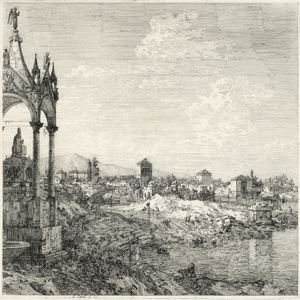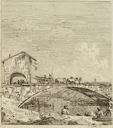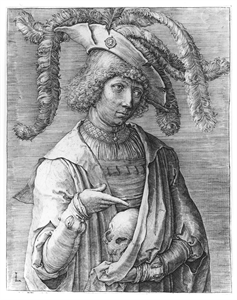
Canaletto (aka Giovanni Antonio Canal)
Italian, 1697–1768
Views, Some Taken from Places, Others Invented (Vedute Altre prese da i Luoghi Altre ideate)
"View of a Town with a Bishop’s Tomb" was printed from a larger plate that Canaletto cut down for an unknown reason. In fact, the artist also bisected the proper right-hand portion of the plate that he severed from "View of a Town with a Bishop’s Tomb". The smallest fragment of the plate exists in only one impression. The vertical plate exists in only one state, but the "View of a Town with a Bishop’s Tomb" was worked into a second state through the addition of lines in the buildings on the right bank of the river, the hills in the distance, and the fountain basin by the tomb. Consequently, this portion of the plate tends to print somewhat darker than the other pieces. Of the three fragments, this is the most effective composition, although it feels incomplete without the two proper right-side parts of the large plate. Still, as Suzanne Folds McCullagh has observed, it demonstrates a “successful evocation of substance and recession in space. Calligraphic freedom enlivens but does not overwhelm the harmony of the scene.”
See "Italian Master Prints of the 18th Century: Selections from the Collection of Mr. and Mrs. Adolph Weil, Jr.," exh. cat., (Montgomery: Montgomery Museum of Fine Arts, 1984), 21-22.
Italian, 1697–1768
View of a Town with a Bishop's Tomb
about 1735–1743; published about 1744–1746Views, Some Taken from Places, Others Invented (Vedute Altre prese da i Luoghi Altre ideate)
Object Type:
Print
Creation Place:
Southern Europe, Italian, Venice
Dimensions:
11 3/4 x 11 7/8 in. (29.85 x 30.16 cm)
Medium and Support:
Etching on paper
Accession Number:
1970.0011
Credit Line:
Gift of Mrs. Julian Wiener, Mrs. Stanley Newhouse, and James Loeb in honor of their father, Lucien S. Loeb
"View of a Town with a Bishop’s Tomb" was printed from a larger plate that Canaletto cut down for an unknown reason. In fact, the artist also bisected the proper right-hand portion of the plate that he severed from "View of a Town with a Bishop’s Tomb". The smallest fragment of the plate exists in only one impression. The vertical plate exists in only one state, but the "View of a Town with a Bishop’s Tomb" was worked into a second state through the addition of lines in the buildings on the right bank of the river, the hills in the distance, and the fountain basin by the tomb. Consequently, this portion of the plate tends to print somewhat darker than the other pieces. Of the three fragments, this is the most effective composition, although it feels incomplete without the two proper right-side parts of the large plate. Still, as Suzanne Folds McCullagh has observed, it demonstrates a “successful evocation of substance and recession in space. Calligraphic freedom enlivens but does not overwhelm the harmony of the scene.”
See "Italian Master Prints of the 18th Century: Selections from the Collection of Mr. and Mrs. Adolph Weil, Jr.," exh. cat., (Montgomery: Montgomery Museum of Fine Arts, 1984), 21-22.
Keywords
Click a term to view the records with the same keyword
Related Objects
Click a record to view

Landscape with Ruined Monuments
1977.0531

The Wagon Passing over a Bridge
1985.0004.0003

The Little Monument
1985.0004.0004

The Tower of Malghera (La Torre di Malghera)
1985.0004.0005

Title Plate
1985.0004.0006

The Portico with the Lantern
1985.0004.0007
Portfolio List
Click a portfolio name to view all the objects in that portfolio
This object is a member of the following portfolios:
Your current search criteria is: Keyword is "I".

 by Artist (34)
by Artist (34)

